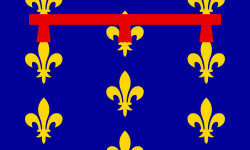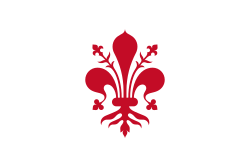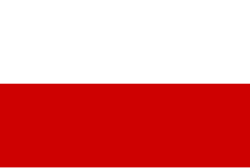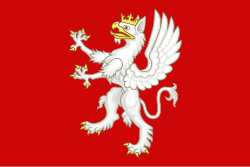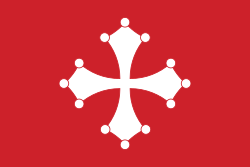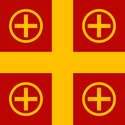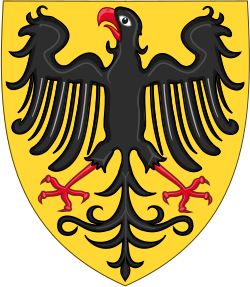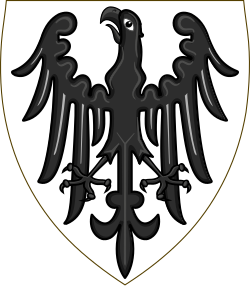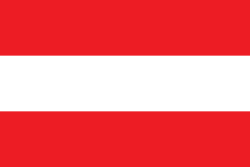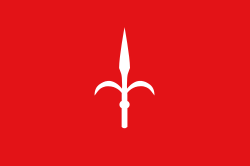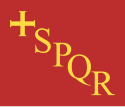Guelfové a ghibellini
| Guelfové a ghibellíni | |||
|---|---|---|---|
| konflikt: Boj o investituru | |||
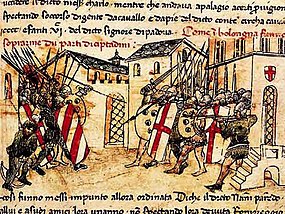 Ilustrace znázorňující potyčku mezi milicemi ve městě Bologna ve 14. století, Kronika Giovanniho Sercambi z Luccy | |||
| Trvání | 1125–1186 první fáze 1216–1392 druhá fáze | ||
| Místo | severní a střední Itálie, Apeninský poloostrov | ||
| Výsledek | první fáze: Kostnický mír (1186) druhá fáze: patová situace (1392)
| ||
| Strany | |||
| |||
| Velitelé | |||
| |||
| Některá data mohou pocházet z datové položky. | |||
Guelfové (italsky guelfi) a ghibellíni (ghibellini) byla dvě mocenská seskupení italských (i německých) šlechtických rodů a měst, která v době středověku bojovala mezi sebou o ovládnutí území střední a severní Itálie. Název ghibellini vznikl zkomolením jména Waiblingen, rodového hradu Štaufů; guelfové je zase italský přepis jména rodu Welfů, kteří soupeřili se Štaufy a stranili papežům.
V době nástupu štaufské dynastie na císařský trůn (1138) se římsko-němečtí císaři snažili politicky i vojensky ovládnout území severní a střední Itálie, které formálně náleželo k Italskému království v Říši římské, avšak ve skutečnosti bylo pod silným vlivem papežů a severoitalské státy byly prakticky nezávislé. V roce 1157 císař Fridrich Barbarossa rozšiřuje název své říše o přídavné jméno „svatá“, tj. Svatá říše římská, což mělo demonstrovat jeho ambice vládnout nad územím Itálie a v Papežském státě.
Boje mezi guelfy a ghibellíny se rozrostly také o spor ohledně Sicilského království, která náleželo Štaufům, ale bylo lénem papežů. Po smrti Fridricha II. (1250) se papež Inocenc IV. rozhodl neudělit Konrádovi IV. království jako papežské léno. V roce 1263 uzavřel papež Urban IV. dohodu s Karlem z Anjou, který se výměnou za Království sicilské v léno neměl na oplátku snažit o ovládnutí Itálie. Karlova nadvláda, vysoké daně a expanzivní politika na Sicílii nakonec vedly k povstání zvanému Sicilské nešpory, která skončila vyhnáním Francouzů z ostrova a nastolení vlády aragonského krále Petra III. Velikého.
Konflikt mezi guelfy a ghibelliny skončil v roce 1392, kdy se octl v patové situaci.
Guelfové

Guelfové (italsky guelfi) je italský přepis jména rodu Welfů. Welfové byl německý rod soupeřící se Štaufy o císařský trůn a v Itálii naopak stranili papežům a Anjouovcům. Do bojů proti Štaufům a jejich ghibellinským stoupencům je podpořili italský rod Este a italská města a italské městské státy:
Ghibellini

Ghibellíni (italsky ghibellini) je zkomolenina jména Waiblingen, rodového hradu Štaufů. Štaufové byli mocným rodem vládnoucím ve Svaté říši římské a na Sicílii. Jako císaři a zároveň králové Itálie a Sicílie nemohli nečinně přihlížet osamostatňujícím se tendencím severoitalských měst a ani nárokům Anjouovců na Sicílii. Do bojů mezi nimi a papeži se k nim přidaly italské rody Gonzaga a Scala a dále jihoněmecká knížata, která je podporovala v boji o císařský trůn vůči Welfům. K této alianci patřila italská města a italské městské státy:
 Arezzo
Arezzo Ascoli Piceno
Ascoli Piceno Assisi
Assisi Asti
Asti- Castiglion Fiorentino
 Ceccano
Ceccano Como
Como Chieti
Chieti Empoli
Empoli Foligno
Foligno Forlì
Forlì Florencie
Florencie Grosseto
Grosseto- Gualdo Tadino
 Jesi
Jesi Mantova
Mantova Modena
Modena- Monte San Pietrangeli
 Milán
Milán Narni
Narni Novara
Novara- Osimo
 Pallaviciniové z Pádské nížiny
Pallaviciniové z Pádské nížiny Pavia
Pavia- Penne
 Pisa
Pisa Poggibonsi
Poggibonsi Santa Fiora
Santa Fiora Verona
Verona Savona
Savona Saluzzo
Saluzzo Spoleto
Spoleto- Sulmona
 Terni
Terni Treviso
Treviso Terst
Terst- Todi
 Urbino
Urbino
A připojila se některá další, jejichž podpora byla střídavá.
Města a městské státy proměnlivé oddanosti
Poznámky
- ↑ Římská komuna v roce 1144 vyhnala papeže z Říma a vyhlásila republiku loajální císaři. Fridrich Barbarossa měl však větší zájem o císařskou korunovaci v Římě, postavil se na stranu papeže a vydal vůdce komuny Arnolda z Brescie papežské moci, který byl poté popraven. V roce 1193 byla papežská vláda nad Římem obnovena.
Literatura
- Franco Cardini: Ghibellinen, Lexikon des Mittelalters, díl. 4, str. 1436–1438.
- Franco Cardini: Guelfen, Lexikon des Mittelalters, díl. 4, str. 1763–1765.
Externí odkazy
 Obrázky, zvuky či videa k tématu Guelfové a ghibellini na Wikimedia Commons
Obrázky, zvuky či videa k tématu Guelfové a ghibellini na Wikimedia Commons - Guelphs and Ghibellines
Média použitá na této stránce
Depiction of a 14th C. fight (1369?) between the militias of the Guelf and Ghibelline factions in the Italian commune of Bologna, from the Croniche of Giovanni Sercambi of Lucca.
Autor: Gambo7, Licence: CC BY-SA 3.0
Gonfalone della chiesa secondo Bonifacio VIII
Při zobrazení tohoto souboru lze snadno přidat orámování
Autor: FDRMRZUSA, Licence: CC BY-SA 4.0
Coat of arms of the Welf-Brunswick family with errors.
Flag of the Kingdom of Naples
Flag of the Comune di Bologna, Bologna, Italy
Flag of Florence (plain with lily shown at City Hall), first used by the Guelphs
Autor: Facquis, Licence: CC BY-SA 4.0
Stemma dei Della Torre con gli elementi essenziali
Flag of Genoa
Při zobrazení tohoto souboru lze snadno přidat orámování
flag of the Duchy of Modena before 1830 according to Flags of the World
Autor: Dekodrak, Licence: CC BY-SA 4.0
Flag of the Republic of Ancona.
Autor: unknown, Licence: Copyrighted free use
Autor: Odvozené dílo: Vale93b, Licence: CC BY-SA 4.0
Bandiera della it:Repubblica di Massa
Flag of Lodi
Autor: Glz19, Licence: CC0
Historical Coat of Arms of the city of Brescia
Autor: Vlastní dílo, Ronald Preuss (eagle), Licence: CC BY-SA 4.0
Royal banner (Königsbanner) of the German kings and emperors in the early to mid 14th century. The upright rectangular shape of the field approximates the proportions of 14th-century military banners, see e.g. File:Codex Balduini Trevirensis - Alpenüberquerung Heinrich VII.JPG
Saint John the Baptist's cross (a white cross on a red background), used as State flag by the Republic of Florence, the Sovereign Military Order of Malta, the Italian city of Como and various other places.
Autor: User:Ssolbergj, Licence: CC BY-SA 4.0
Or three leopards sable.
Modified from File:Insigne Estonicum.svg with the following replacements:
- 61b3fd-->616161
- 2b96f6-->2b2b2b
- 214478-->212121
- 1353b4-->131313
- 1265b1-->121212
- 02378b-->040404
- 003386-->030303
Autor:
- King Manfred of Sicily Arms.svg: Heralder
- derivative work: The White Lion
Banner of the Kings of Sicily under the House of Hohenstaufen.
Manfred, King of Sicily (r. 1258-1266) is known to have changed the field of the royal coat of arms to argent.
Some Nuova Cronica mss. illustrations of the early 14th century show military banners with the design alongside the coat of arms (e.g. ms. Chigiano L VIII 296.Autor: Facquis, Licence: CC BY-SA 4.0
Bandiera rappresentata nel dipinto "Madonna con il Bambino" di Timoteo Viti conservato alla pinacoteca di Brera
Autor: HapHaxion, Licence: CC0
Flag of Florence used by the Ghibellines from the 11th century until their defeat in 1250
Autor: Facquis, Licence: CC BY-SA 4.0
Stemma dei Della Torre sovrastato dall'aquila imperiale conferita nel 1274 a Napoleone Della Torre
Autor: Facquis, Licence: CC BY-SA 4.0
Bandiera della Signoria di Milano
Flag of the Republic of Pisa
Autor: Dekodrak, Licence: CC BY-SA 4.0
Flag of the Marquisate of Saluzzo.
Autor: Giosuè Tacconi, Licence: CC BY-SA 4.0
Banners of Terni's ghibellines at Montaperti (in first half of 13th century).
Autor: Dragovit, Licence: CC BY-SA 4.0
Arms of the Emperor of Constantinople according to Gelre Armorial (1484.: Die Keyser von Constantinopel)
(c) Heralder, CC BY-SA 3.0
Arms of Otto IV, Holy Roman Emperor (Attributed with personal arms inescutcheon).
(c) Heralder, CC BY-SA 3.0
Arms of the Holy Roman Emperor, (Frederick I, Henry VI, and Frederick II.) Attributed with personal arms escutcheon.
(c) Heralder, CC BY-SA 3.0
Arms of Henry VII, Holy Roman Emperor (Attributed arms with personal inescutcheon).
(c) Heralder, CC BY-SA 3.0
Arms of Louis IV, Holy Roman Emperor (Attribued arms with personal arms escutcheon).
Autor: Heralder & Tom Lemmens, Licence: CC BY-SA 3.0
Shield and Coat of Arms of the Holy Roman Emperor, drawn in the style the late medieval period.
Also used as shield of arms (generic) by the King of the Romans
Autor:
- Shield and Coat of Arms of the Holy Roman Emperor (c.1200-c.1300).svg: Heralder & Tom-L
- Derivate work: The White Lion
Coat of Arms of the Kingdom of Sicily (House of Hohenstaufen)
coat of arms of House of Montefeltro.
Flag of the city of Atri, Abruzzo, Italy
Flag of Assisi
Autor: Lorenzo Capuani, Licence: CC BY-SA 4.0
Lo stemma riprende quello del cardinale Annibaldo da Ceccano
Flag of Chieti
Autor: Facquis, Licence: CC BY-SA 4.0
Arma dei Pallavicino
Flag of the city of Savona, Liguria, Italy
Coat of arms of Irslingen in Dietingen
Autor: Původně soubor načetl Kuemmjen na projektu Wikipedie v jazyce němčina
Current version by Arlon Stok, Licence: CC BY-SA 3.0
Flag of Free Territory of Trieste
State Flag of the Republic of Florence.
Flag of Rimini
Autor: Artemis Andromeda, Licence: CC BY-SA 4.0
The banner of the city of Rome, used in the Middle Ages
Autor: ashoppio, Licence: CC BY-SA 4.0




